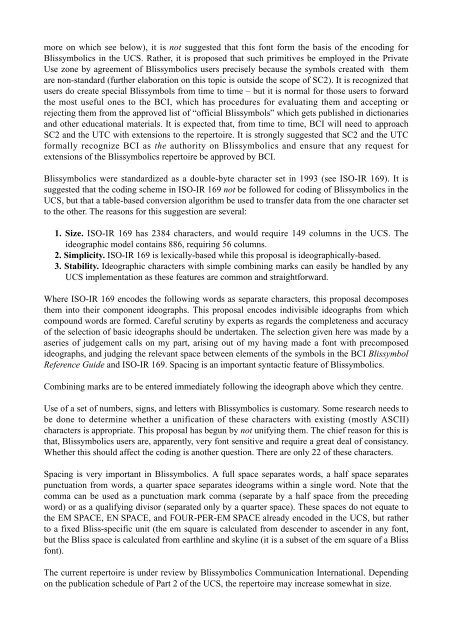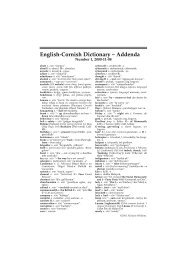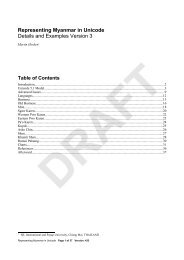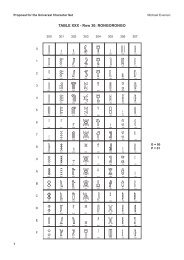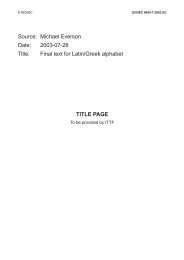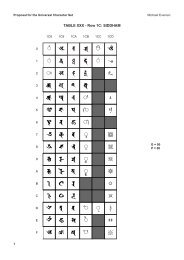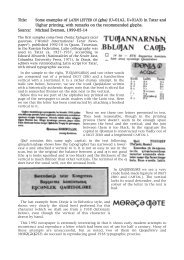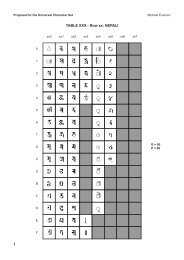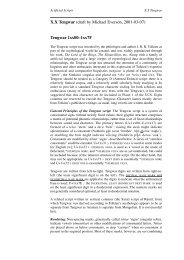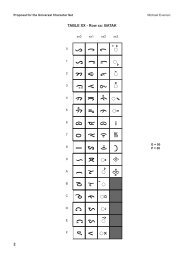Blissymbolics - Evertype
Blissymbolics - Evertype
Blissymbolics - Evertype
Create successful ePaper yourself
Turn your PDF publications into a flip-book with our unique Google optimized e-Paper software.
more on which see below), it is not suggested that this font form the basis of the encoding for<br />
<strong>Blissymbolics</strong> in the UCS. Rather, it is proposed that such primitives be employed in the Private<br />
Use zone by agreement of <strong>Blissymbolics</strong> users precisely because the symbols created with them<br />
are non-standard (further elaboration on this topic is outside the scope of SC2). It is recognized that<br />
users do create special Blissymbols from time to time – but it is normal for those users to forward<br />
the most useful ones to the BCI, which has procedures for evaluating them and accepting or<br />
rejecting them from the approved list of “official Blissymbols” which gets published in dictionaries<br />
and other educational materials. It is expected that, from time to time, BCI will need to approach<br />
SC2 and the UTC with extensions to the repertoire. It is strongly suggested that SC2 and the UTC<br />
formally recognize BCI as the authority on <strong>Blissymbolics</strong> and ensure that any request for<br />
extensions of the <strong>Blissymbolics</strong> repertoire be approved by BCI.<br />
<strong>Blissymbolics</strong> were standardized as a double-byte character set in 1993 (see ISO-IR 169). It is<br />
suggested that the coding scheme in ISO-IR 169 not be followed for coding of <strong>Blissymbolics</strong> in the<br />
UCS, but that a table-based conversion algorithm be used to transfer data from the one character set<br />
to the other. The reasons for this suggestion are several:<br />
1. Size. ISO-IR 169 has 2384 characters, and would require 149 columns in the UCS. The<br />
ideographic model contains 886, requiring 56 columns.<br />
2. Simplicity. ISO-IR 169 is lexically-based while this proposal is ideographically-based.<br />
3. Stability. Ideographic characters with simple combining marks can easily be handled by any<br />
UCS implementation as these features are common and straightforward.<br />
Where ISO-IR 169 encodes the following words as separate characters, this proposal decomposes<br />
them into their component ideographs. This proposal encodes indivisible ideographs from which<br />
compound words are formed. Careful scrutiny by experts as regards the completeness and accuracy<br />
of the selection of basic ideographs should be undertaken. The selection given here was made by a<br />
aseries of judgement calls on my part, arising out of my having made a font with precomposed<br />
ideographs, and judging the relevant space between elements of the symbols in the BCI Blissymbol<br />
Reference Guide and ISO-IR 169. Spacing is an important syntactic feature of <strong>Blissymbolics</strong>.<br />
Combining marks are to be entered immediately following the ideograph above which they centre.<br />
Use of a set of numbers, signs, and letters with <strong>Blissymbolics</strong> is customary. Some research needs to<br />
be done to determine whether a unification of these characters with existing (mostly ASCII)<br />
characters is appropriate. This proposal has begun by not unifying them. The chief reason for this is<br />
that, <strong>Blissymbolics</strong> users are, apparently, very font sensitive and require a great deal of consistancy.<br />
Whether this should affect the coding is another question. There are only 22 of these characters.<br />
Spacing is very important in <strong>Blissymbolics</strong>. A full space separates words, a half space separates<br />
punctuation from words, a quarter space separates ideograms within a single word. Note that the<br />
comma can be used as a punctuation mark comma (separate by a half space from the preceding<br />
word) or as a qualifying divisor (separated only by a quarter space). These spaces do not equate to<br />
the EM SPACE, EN SPACE, and FOUR-PER-EM SPACE already encoded in the UCS, but rather<br />
to a fixed Bliss-specific unit (the em square is calculated from descender to ascender in any font,<br />
but the Bliss space is calculated from earthline and skyline (it is a subset of the em square of a Bliss<br />
font).<br />
The current repertoire is under review by <strong>Blissymbolics</strong> Communication International. Depending<br />
on the publication schedule of Part 2 of the UCS, the repertoire may increase somewhat in size.


